Cerro de las Minas facts for kids
Cerro de las Minas is an amazing ancient city in Oaxaca, Mexico. It's located on a big hill near the city of Huajuapan de León. This site was once a very important place for the Ñuiñe (pronounced "Nwee-nyay") culture, a group of Mixtec people.
The hill offered a great view of the valley below. This meant the people living there could easily protect their city. They also had access to good farmland for food and important trade routes. Cerro de las Minas was a special place, mostly for the leaders and important families of the area. Today, it's the only ancient Ñuiñe site in the lowlands that you can visit!
Contents
Discovering an Ancient City
Archaeologists have studied Cerro de las Minas for many years. Dr. John Paddock first explored the site in the 1960s. He helped us understand the Ñuiñe culture. Later, Dr. Marcus Winter did more big digs in 1987. Their work helped uncover the secrets of this ancient city.
Life in Cerro de las Minas
About 2,500 years ago, many Mixtec communities lived in this part of Mexico. The people who lived at Cerro de las Minas were called Ñuu Yata Yata, which means "ancient people."
Early Beginnings (Ñudee Phase)
The city started around 400 BCE (Before Common Era). This early time is called the Ñudee phase. The first settlers came from a nearby site called Santa Teresa. They began to build their community on the hill.
A City Flourishes (Ñuiñe Phase)
From about 250 CE (Common Era) to 800 CE, Cerro de las Minas grew into a powerful city-state. This was the Ñuiñe phase, its most important time. Other big cities like Monte Albán and Teotihuacan were also thriving then.
Cerro de las Minas became a major center for trade, politics, and culture. It influenced an area about 10 to 15 kilometers wide. At its busiest, between 1,000 and 2,000 people lived here.
The city was part of important trade routes. These routes connected the Valley of Mexico with other regions. People traded things like obsidian (a volcanic glass), pottery, cloth, metals, salt, and even plants and fruits.
The City's Decline
Around 800 CE, Cerro de las Minas started to lose its power. It might have been taken over by a nearby kingdom. The area didn't grow much again until after the Spanish arrived in the 1500s. The modern city of Huajuapan was founded in the valley below in 1525.
Exploring the Ancient City
The main part of Cerro de las Minas covers about 50 hectares (that's like 100 football fields!). The people chose this hill because it was easy to defend.
Main Structures
The center of the site has three large mounds, each about eight meters tall. These mounds are lined up and have big platforms connecting them. Together, they stretch for about 180 meters.
There's also a Mesoamerican ball court here. It's 60 meters long and 15 meters wide. Imagine ancient athletes playing a game with a rubber ball!
The sides of the hill were shaped into flat areas called terraces. These terraces created more space for homes, a market, and even a palace.
Homes and Burials
The houses usually had stone foundations. Their walls were made of stone or adobe (a mix of mud and straw). Important families often had graves right inside or near their homes. This was a special way to honor their ancestors.
The palace complex had many rooms, a central courtyard, and a large tomb, called Tomb 5. This tomb held the remains of three important people, likely from the ruling family. Archaeologists found nine tombs in total. Some had been robbed, but others still contained human remains, pottery, and special gravestones. More than 100 regular graves were also found.
Amazing Discoveries
Many important discoveries were made at Cerro de las Minas. A team led by Marcus Winter worked here in the late 1980s and early 1990s. They learned a lot about the Mixtec writing system from this site.
Tomb 5 Treasures
Tomb 5 was especially rich in finds. It contained lots of Mixtec pottery. One beautiful, colorful urn showed a god of wind or fire. This god had a brazier (a container for hot coals) on its head and sat on a platform with four special symbols. This urn is now in the Museum of Oaxaca.
Most of the Ñuiñe writing found was on gravestones in Tomb 5. This writing usually showed the name of the person who died, along with dates. Two such gravestones, likely belonging to the city's rulers, were found here.
Connections to Other Cultures
The items found at Cerro de las Minas show that these people had contact with other Mixtec settlements. Places like Diquiyú, Monte Negro, Huamelulpan, Yucuita, and Yucuñudahui all influenced each other.
Even after six years of digging, much of the site is still unexplored. There's still so much more to learn about this fascinating ancient city!
What You Can See Today
Structure H1A
This structure sits at the very top of the hill. It was probably an ancient temple. People would have climbed a wide staircase to reach it.
Mound 1
This mound hasn't been fully explored yet. It likely had a staircase leading to another temple on top.
Mound 2
This is a large, flat platform with tall walls. It might have had homes on its northeast side.
Main Plaza
This open area is located between Mound 1 and Mound 2. The courtyard for Tomb 5 is here, surrounded by ancient homes.
Tomb 5
This important tomb held the remains of several people, over 70 pieces of pottery, and a beautiful Ñuiñe urn. The walls of the tomb's courtyard show special building techniques.
Ballgame Court
Near Mound 2, archaeologists found clues of a possible ball court. Even though houses were built over it later, its long shape and two small carved stones suggest it was once used for the ancient ballgame.
Mound 3
This mound is still waiting to be explored. The space between Mound 2 and Mound 3, like the Tomb 5 patio, is thought to have been a Tianguis (an ancient market).
Where to See the Finds
Many of the amazing objects found at Cerro de las Minas are on display. You can see them at the Huajuapan Community Museum. Other pieces are in the Oaxaca Cultures Museum and the Mitla Frissell Museum.
See also
 In Spanish: Cerro de las Minas para niños
In Spanish: Cerro de las Minas para niños



